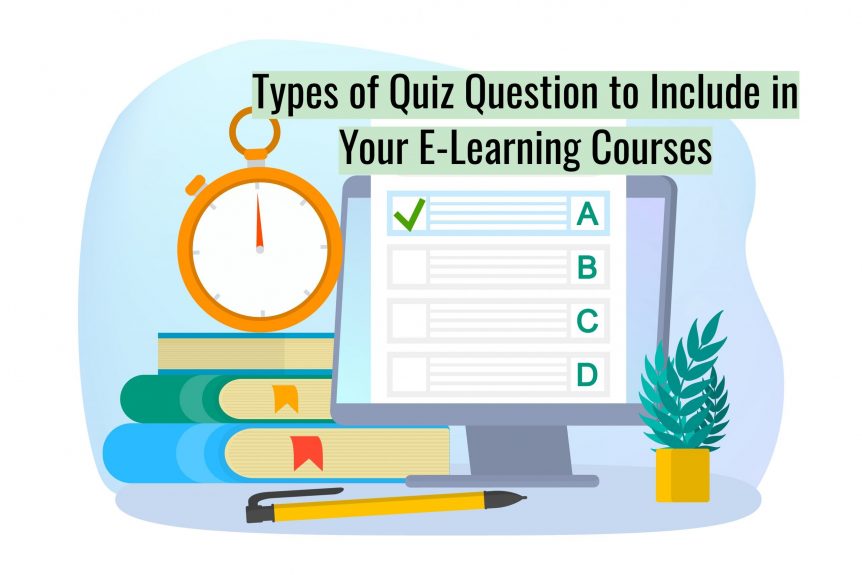11 Types of Quiz Question to Include in Your E-Learning Courses
Quizzes are a fundamental component of most e-learning courses. So, if you are developing a new e-learning course, you will need to create a quiz. When doing so, there are 11 main types of quiz questions that you can include. By mixing up the various types, you can make your quizzes more engaging, interesting, and enjoyable.
-
Multiple Choice
Multiple choice questions are among the most common types of questions found in e-learning courses. They involve a question with multiple options, with the learner selecting the correct or best option to answer the question.
You can construct multiple choice questions in a range of ways, from making the correct answer fairly obvious to giving options that could all potentially be correct. In the latter approach, the objective is to truly challenge the learner while also ensuring they have a full understanding of the topic.
-
Multiple Response
The multiple response question type is similar to a multiple-choice question, except the learner can choose multiple options in their answer instead of just one.
-
Match the Pair
Match the pair questions typically involve presenting the learning with two lists. Those lists could be words, phrases, or images. To answer the question, the learner matches each option in the first list with one in the second.
Match the pair questions are a way to ask several questions in one.
-
Yes or No
A yes or no question is one where you ask a question and then give the learner only two options as the answer – Yes or No. These types of questions are an opportunity to really challenge the learner to think about the answer. For example, asking a question that a learner might have given a nuanced answer if they could. By forcing them to answer either yes or no, you are encouraging the learner to really contemplate their answer.
-
True or False
A true or false question is similar to a Yes or No question as there are only two possible answers – in this case, True or False. Typically, these types of questions are used to assess understanding.
-
Fill in the Blanks
With this type of question, you present the learner with a sentence or multiple sentences. The sentences have missing words, which the learner needs to complete.
You can use different mechanics for this type of question, depending on how difficult you want the question to be. For example, an easier option for a fill in the blank question would be one where learners are given the possible answers, which they then drag and drop into the sentences. A more difficult option would be one where there are no possible answers given. Instead, the learner must type the answers in the blank spaces.
-
Open-Ended Questions
Open-ended questions give learners a text box that they can then use to write their answer. That answer could be a sentence or two or a paragraph.
This type of question is especially beneficial if you want to get a detailed understanding of the learner’s knowledge as well as what they think about a topic, particularly a complex topic. Or where you want to understand the learner’s point of view.
-
Short Answer
A short answer question is one that has a word or short phrase as the answer but where you don’t provide any potential options. As the learner has to type the answer, short answer questions are often more difficult than alternative question types, such as multiple-choice questions.
-
Sorting, Classification, or Sequencing Questions
This type of question involves putting options in the correct order, sorting options into categories, ranking options, etc. An example is putting the steps in a process in the right order.
A sorting-type question could be as simple as a list of options that need to be sorted, or it could be more visual. An example of the latter is an image where the learner drags and drops elements into the right place.
-
Hotspot
Hotspots are visual questions where you present learners with a question and an image. The learner then selects the part of the image that correctly answers the question.
-
Select from a List
This type of question is a combination of fill in the blank and multiple choice. So, you give learners sentences with missing words or phrases. In each blank section, the learner chooses an option from a list. These types of questions can be tricky, depending on how difficult you want the quiz to be. As a result, select-from-a-list questions can be a good learning tool.
Keeping Learners Engaged, Enhancing the Learning Experience, and Maximising Results
The quizzes you include in your e-learning courses have several functions. They are a way of assessing knowledge and understanding, for example. This information can show you the effectiveness of the course, where the course could be improved, and who might require additional training. Assessing knowledge of the topic is also beneficial for the learner as it shows them the areas they need to work on.
You can also use quizzes to teach and improve understanding. An example is to use mistake-driven learning. With mistake-driven learning, quizzes have a training purpose rather than an assessment purpose.
Finally, quizzes are a good way to improve levels of engagement. You can make them fun and interesting, plus they are interactive, enhancing the overall learning experience.
